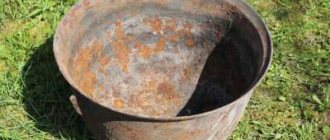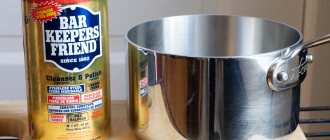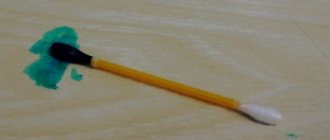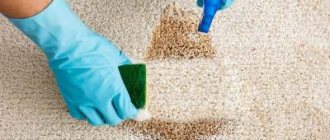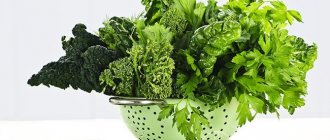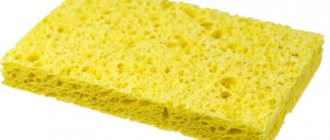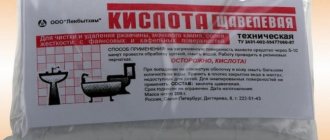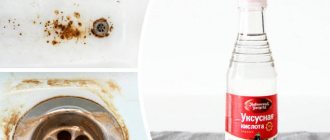The plastic itself does not rust, but if it comes into contact with metal, it may leave red marks on it. They can often be found on window sills, under flower pots, on panels, where shelves are attached, on the ceiling, in the area of lampshades and more.
Rust can appear on the plastic parts of a refrigerator or washing machine, the list is endless. How to wash plastic from rust?
Read the article about what folk and professional remedies exist to wash off rust from plastic at home.
Additional Tips
You can use any suitable method to remove rust marks from a knife.
When choosing a product, you should focus on the degree of contamination, financial costs and the possibility of using the method. In any case, it is advisable to take into account additional recommendations that will facilitate the cleaning process and help speed it up:
- If the rusty coating is significant and has not disappeared completely after the first treatment, it is necessary to repeat the cleansing with the same product or choose a different one.
- If the corrosion process has gone far and a solid, dense coating of rust has formed on the knife, then it is advisable to first remove it mechanically (with sandpaper), and then complete the cleaning with any liquid agent.
- When using any chemical reagents, it is necessary to wear rubber gloves to protect your skin.
- After complete removal of rusty traces, the blade is thoroughly washed with water and dried well. The presence of moisture can reinitiate corrosion.
General rules
Rust occurs from the interaction of oxygen with untreated metal. It also often appears in places with high humidity or when metal interacts with water. Often the surface of the metal is coated with various compounds to provide protection from external influences, but if rust does appear, there are several ways to remove it.
There are several rules and tips that will help you remove rust stains from various surfaces at home:
- Removing rust from any surface involves the use of acids. Therefore, you should always have rubber gloves and wear them when working with chemicals;
- When cleaning, remove children and pets from the premises. After work, ventilate the room;
- Be sure to wash other contaminants from the surface before removing rust;
- Before cleaning rust, rinse the area with water and wipe dry.
Complex contaminants
In addition to the usual stains of grease and dirt, there are also complex stains on plastic panels that are difficult to deal with ordinary detergents. These include residual sealant, marker, ink, severe rust, and brilliant green. They are more difficult to remove, but still possible.
Rust and limescale
Rust on a plastic panel is usually formed from corrosion of old pipes. Limescale deposits occur in the bathroom due to exposure to hard water. You can get rid of these contaminants by the following means:
- acetic acid;
- hydrochloric acid;
- a mixture of ammonia and peroxide (1:10);
- lemon juice;
- "Domestos";
- universal cleaner "Mr. Muscle."
Tobacco smoke
In rooms where people smoke, plastic panels quickly become yellow and have an unpleasant odor. If you don’t clean them for a long time, then it will be very difficult to get rid of nicotine deposits. Traces of cigarette smoke from surfaces can be washed in several ways:
Prepare a mixture of 50 ml of white and 10 liters of water. Moisten a soft cloth with it and wipe the plastic evenly, in one direction, so that there are no streaks left. If the plastic panel is plain, has no patterns and is not made in bright colors, it can be washed from tobacco smoke using vinegar and vodka
You need to moisten a foam sponge in the prepared solution and carefully wipe the yellowed areas with it. After processing, the plastic should be rinsed with water and dried. The easiest way to remove nicotine from plastic panels is to use a melamine sponge
It needs to be moistened with water and wiped off the problem areas. You can also wash plastic from tobacco deposits with soapy water. It should be prepared from water and grated soap with a low alkali content. Moisten a rag with the resulting liquid and wipe the dirty area.
Zelenka
The green stuff is quite difficult to remove. A regular cleaner does not always cope with such stains, especially old ones. If the plastic is white and plain, then it can be washed with a chlorine-containing substance in a matter of seconds.
If the plastic panel is colored, then a fresh stain from the green paint can be removed with washing powder, soap solution, kerosene or gasoline. The last two liquids should be used in minimal quantities in a well-ventilated area. If there are children or animals in the house, then gasoline and kerosene are not recommended.
Sealant
Traces of sealant on the plastic are washed with a solution of ammonia. It is necessary to dilute 20 ml of ammonia in water (1 liter) and treat problem areas with this liquid. Next, you need to rinse the plastic with water and dry it.
Markers
When there are children in the family, housewives often have to struggle with children's works of art on the walls and furniture. Felt pens, markers and even pens can be washed well with sulfur matches. To do this you need:
- Remove sulfur from several matches and soak it in a small amount of water for 15 minutes. It should turn into mush.
- The prepared product should be applied to the painted area of plastic and left for 10 minutes.
- Rinse off any remaining paste with water and wipe the plastic dry.
Plastic panels are an undemanding, weather-resistant material that is easy to care for. It is enough to wipe its surface at least once a month with detergent. If contamination appears, then it is quite possible to deal with it using improvised means.
Caring for kitchen wall panels
To wash wall surfaces, you need to determine in advance the degree of contamination and prepare everything you need, put on gloves and hats. Each type of cladding has its own characteristics, but there are general cleaning rules.
When working, you should adhere to a certain order:
- Provide a convenient approach to the walls, move furniture and washing machine, remove paintings, clocks, lamps. This will make the job easier and prevent the possibility of injury.
- Do not use hot or cold water; its temperature should not be higher than 40 °C.
- Clean the seams between the panels with a rubber spatula or a soft brush. These same tools are suitable for removing grease and dirt in corners near a table or stove.
- If chemicals are used, test the surface in an inconspicuous area by applying a small amount and waiting 5-10 minutes.
- Remove traces of paint and ink, remove grease stains and other contaminants, keeping in mind that, unlike plastic, MDF panels cannot be washed with products containing chlorine or alkali.
- Clean façade reliefs with a brush or sponge. Clean the main surface with detergent or a solution of washing powder. Finally, rinse everything with clean water and wipe dry.
When you're done cleaning the plastic panels, apply polish to brighten colored tiles and add shine to white ones.
General cleaning is carried out at least once a year. To maintain cleanliness, you need to wipe the walls monthly with a damp cloth.
Pros and cons of deletion
Using vinegar to combat rust stains, you can appreciate a number of positive aspects:
- The versatility of the product (vinegar solution perfectly removes red stains from metal, plastic and ceramics).
- Availability (low cost, vinegar solution is available in any kitchen).
- Efficiency (at a pH of 2.5 pH, the vinegar solution dissolves stubborn stains of rust, grease and lime in a matter of minutes).
The downside to using a vinegar solution to remove rust stains is that it has a pungent odor.
An open window in the room and a few drops of your favorite essential oil, previously added to the cleaning solution, will help solve the problem of unpleasant odor.
How to clean a plastic window sill (video)
Even if you buy expensive and high-quality plumbing fixtures, the problem of rust in the bathroom and kitchen will not lose its relevance. Water flowing through old sewer pipes picks up rust, which then settles in snow-white toilets, bathtubs, and sinks. Scrubbing off red stains is labor-intensive, and I want to find a miracle remedy that makes this task easier. But you won’t be able to wash everything with one cleaning product, because different materials react differently to household chemicals.
Task 1: remove rust from the toilet
Secrets of cleaning plastic panels in the bathroom and kitchen
The plastic used for bathroom finishing is classified as a cleanable coating. But regular exposure to high humidity conditions contributes to the appearance of specific contaminants:
- yellowish from rust;
- dust, splashes of dirt;
- limescale from hard water;
- mold, fungus.
It is difficult to clean fungal lesions. They appear on the walls and ceiling in the form of black dots ingrained into the structure of the material. Accumulations of fungus are found in different places, but more often near pipes where condensation forms. If there is a rusty streak near the mold, check the pipes. The problem arose due to poor quality plumbing.
To tidy up the surface of the panels, gel or cream products are used. Cleaning is carried out with soft sponges and rags. Suitable for work:
- acrylic, foam rubber, melamine sponge;
- cotton fabric.
Abrasive detergents, brushes, steel wool, and hard brushes are prohibited for use. The devices scratch the plastic, leaving places for dust and new contaminants to accumulate.
Having decided to wash the plastic panels located in the bathroom, use:
- soft liquids, gels;
- creams, cleaning liquids;
- paste-like compositions against difficult stains;
- remedies for fungal plaque.
Chlorine-containing products are used against mold. You can use bleach diluted with water.
To remove marks from felt-tip pens, ballpoint pens, and pencils, the sulfur head of a match is briefly placed in water. The resulting paste is applied to the stain and left until the pattern is completely dissolved. Wash off any remaining residue with soapy water.
Bleaching agents will help wash off brilliant green and other caustic substances. Before use, test in an inconspicuous area so that the outer layer is not damaged.
The kitchen, like the bathroom, is a specific place. PVC here is exposed to many factors, including grease from food, cigarette smoke, and splashes from detergents. To prevent stubborn stubborn marks from causing problems, you need to regularly clean using the following products:
- ammonia solution: take 1 tbsp for 1 liter of water. alcohol;
- baking soda paste: baking soda is mixed with water to form a thick paste and applied to difficult stains. Rub effortlessly to avoid scratching the panel.
The following diagram will help you wash the plastic panels on the ceiling in the kitchen:
- Vacuum the surface to remove large dust particles.
- Prepare a cleaning solution from available products and apply to the ceiling.
- Wait until the dirt softens.
- Wash with a soft sponge or cloth.
- Dry and rinse with clean water.
- Wipe dry.
If dirt gets into the connecting seams, it is difficult to clean it. It will not be enough to wash the plastic ceiling in the kitchen; you will need to dismantle the finishing, clean it and reassemble it.
What devices are best to use to avoid damaging the panels?
Before you start cleaning, you should prepare tools that can be used to effectively and safely clean plastic panels:
- soft cotton fabrics;
- soft sponges with a fine-pored structure;
- melamine sponge;
- acrylic sponges;
- Before washing the plastic panels on the ceiling, you should purchase a special mop with a sponge and a telescopic handle.
Specifics of different types of plastic surfaces
Plastic is a practical and durable facing material that combines an attractive appearance and ease of maintenance. The diversity allows you to make your interior unique by choosing the most suitable type of panels:
- Glossy. This plastic is coated with a special varnish, can be narrow or wide, and is used on the walls and ceiling of the kitchen, bathroom, and hallway. A little dust accumulates on it, mold and mildew practically do not stick, but splashes from water, marks from markers, rusty smudges, and grease are visible. All this reduces shine over time. Products used for such surfaces should not leave streaks and contain abrasive particles.
- Matte. It has a special texture, can imitate wood or brick, creating a unique style. This is both an advantage and a disadvantage of such plastic, since any unevenness retains dirt and soot, which is more difficult to wash out. It is advisable to pre-soak the matte surface by applying detergent and leaving for 15-20 minutes, then rinse and dry thoroughly.
- Decorated . If an image is applied to the surface, the dirt is absorbed more strongly, although sometimes it is not so noticeable. When choosing products that will help wash PVC panels, you need to consider whether the film or printed method of applying decor is used. Such surfaces should not be rubbed and abrasives should not be used on them.
In size, the plastic cladding can be slatted, in the form of tiles or sheets, with or without seams at the joints. Dirt is concentrated as much as possible at the joints; stains remain on a large surface when washed, which is why their cleaning methods differ.
Usually the walls in the kitchen are decorated with decorated, textured plastic or clapboard. The apron and places near the sink are smooth slabs, the ceiling is plain. But various combinations are allowed, the use of skirting boards and friezes that add zest to the interior.
Given the large selection of cleaning products for plastic surfaces, you can always choose the one that suits your specific conditions.
Home methods for dealing with contamination of PVC panels
To clean the panels, you don’t have to look for products in the store and spend money. Take a look at your home supply of products and find what you need for effective cleaning.
Soda
How to prepare washing powder: dilute the required amount of soda with water to a paste.
Moisten a sponge in the resulting paste and apply to the dirty area. Leave to act for several hours, then clean and rinse with running water. Wipe with a dry cloth.
Use the product carefully. Soda consists of tiny particles that can scratch the plastic and lose its visual appeal.
Vinegar and alcohol
Do not use liquids on products with printed designs!
To tidy up the panels, you need to moisten a sponge in a small amount of alcohol, vodka or vinegar 9%. Rub well. Rinse off with cool water.
If you need to wash colored plastic ceilings or walls, dilute vinegar with water in a ratio of 1:3. Test the reaction on a small, inconspicuous area before applying.
Care and prevention
In order not to be tormented by the question of how to properly wash plastic, it is better to prevent it from becoming dirty or to reduce the likelihood of its occurrence to a minimum. Here are a few basic recommendations that will help keep plastic items in good condition for a long time:
In fact, you don't need any special knowledge or skills to clean plastic quickly and easily. After studying the recommendations discussed in this article, even a novice housewife can do this.
What is the best way to clean a plastic kitchen?
In such rooms, plastic products are also exposed to constant high temperatures. Fatty deposits, which accumulate as a result of constant cooking, also have a negative effect. However, it is still possible to solve the problem.
When cleaning kitchen surfaces, substances are used that are harmless to the body, since they can enter the esophagus with food or due to contact of dishes with the surface:
- If it's not a glossy product, you might want to try mustard powder. This method does not require dilution with water, but is used dry - that is, it has a mechanical effect. Sprinkle the powder onto the affected surface and wipe with a cloth.
- The same trick can be done with regular baking soda. Rub the countertop with a sponge and leave for 20 minutes, and after the time has elapsed, rinse thoroughly.
- In some cases, sunflower oil diluted with water will be effective. Keep the proportions two to one. Apply the resulting liquid to the affected area for 15 minutes, and then wipe with a damp cloth.
Tools and materials
There are a huge number of rust removers, so you can choose what you need for each surface. Various chemistry is often used to produce the desired reactions, but the use of chemistry presupposes knowledge and skills in this area, so this option can be called effective, but not the simplest. Simple options include those that involve the use of improvised means:
- Natural tomato sauce. It should be applied to the affected surface, then the rust can be easily removed with a brush;
- Baking soda. You need to make a thick solution of soda. The part is placed in it for a while, then cleaned with water. For the desired effect it is necessary to repeat several times;
Home Recipes
It is quite possible to clean the refrigerator until it turns white using improvised products that are already in the kitchen or in the home medicine cabinet. It is advisable to carry out all work wearing rubber gloves to protect the skin of your hands.
Soap solution
To clean the refrigerator outside and inside, you can use a solution of laundry soap.
Procedure:
- grate the soap - this will make it easier to dissolve in water;
- dilute soap shavings in hot water, proportion – 1-2 spoons per 0.5 liter. water;
- thoroughly rinse all surfaces with a napkin;
- rinse with clean water.
If you don't have laundry soap on hand, you can use any other soap. Even liquid will do. For old contaminants, this method may not be effective.
Soda
Soda is a good, healthy product that can be used to clean various surfaces, including those that come into contact with food.
To clean, you need to dilute the powder with water to form a liquid paste. You can wipe off dirt with baking soda using a napkin, periodically dipping it into the solution.
If the area is very dirty, it is advisable to leave the napkin in the soda solution to lie on the dirty area.
Dishwashing gel
Cleaning products designed for washing dishes are suitable for removing dirt from internal and external surfaces. This removes fingerprints, deposited gas and grease.
To clean the refrigerator, you need to take a damp sponge and squeeze out excess water from it. Apply a small amount of detergent directly to the sponge and begin processing.
Another option for using the gel is to dilute it in any amount directly in a bowl of hot water. After cleaning, the soap solution must be rinsed off and all surfaces must be wiped dry.
If the condition of the surfaces is neglected, additional treatment with another preparation may be required.
How to remove hydrogen peroxide?
Peroxide is a proven solution for brightening surfaces and removing stains.
This cleaning method will help cope with even advanced cases, since hydrogen peroxide is a fairly aggressive agent.
To eliminate local yellow spots, the drug is applied to a sponge directly from the bottle. Changing sponges as they become dirty, carry out methodical processing.
For crystal white results you may need to treat the same area up to three times.
Ammonia
Ammonia will help remove yellowing from the surfaces of the refrigerator. This is also the prevention of mold.
If ammonia is used as a means of regular care, then you can simply wipe the refrigerator inside and out with it. But in cases where there is obvious yellowing, the product must not only be applied generously, but also left for half an hour. After that, wash it off.
When the refrigerator is in disrepair, it is recommended to use ammonia not even as a stand-alone cleaning product, but together with toothpaste. So the effect will be much higher.
Vinegar
To eliminate yellowness, you can use both table vinegar and concentrated vinegar essence.
In the latter case, the effect will be much higher. The effect is achieved due to the brightening effect of the acid.
Apply vinegar essence to a napkin and methodically treat all yellow spots. If the problem is not solved the first time, the process is repeated.
Cider
Thanks to the acid contained in cider, it can also be used to clean surfaces from yellowness.
But you need to use it diluted:
- Pour 1 glass of cider into 1 liter of water.
- Stir.
- Using a sponge, wipe all yellowed surfaces.
Lemon acid
Citric acid has disinfectant and lightening properties. As an alternative, you can use juice squeezed from fresh lemon. But the effect will be lower.
To prepare an aqueous solution you will need:
- 0.5 l. warm water;
- 2 tbsp. l. acids.
Prepare the solution in such a way that no undissolved grains remain. You need to moisten a sponge in the resulting liquid and wipe the areas of the surface that need to be lightened.
We fight traces of rust on glass
On this type of material, you can use any method described in this article. But products containing acids and the proven method of using Coca-Cola have proven themselves best. One feature: the time to clean rusty marks from glass is unlimited, that is, the interaction of a particular substance on a given material can be as long as necessary to completely eliminate the contamination.
Dear visitor! If you know other methods on how to remove stains, please leave your experience in the comments.
What products should not be used to clean a plastic kitchen?
- Using abrasives and hard sponges. They erase the top layer of the product, and the surface becomes not as smooth as before. As a result, it becomes more difficult to clean.
- Chlorine-containing products. Such solutions can discolor the surface, and the kitchen will look faded.
- Polishes containing wax. As a result of treatment with such means, the plastic becomes sticky and collects all the dust and dirt.
- Alcohol-containing products. The material from which the facade is made may fade and lose its former color.
- 5. Means for washing kitchen stoves and plumbing fixtures. They contain aggressive components that can leave indelible stains and cloudiness on the facade.
What you need for cleaning
The surface of window sills varies. Smooth plastic can simply be washed with a regular microfiber sponge or fleece cloth. But if the texture of the window sill is porous or rough, small particles of dust get stuck in it and are more difficult to wipe off. Use a stiff sponge or brush.
Do not use metal scrapers or abrasive materials for cleaning; they leave behind micro-scratches that spoil the appearance of the window sill and collect various dirt.
A large amount of dirty residue usually collects in the cracks under the frame, and it is difficult to soak it and remove it with a simple sponge. How to clean plastic from stains in hard-to-reach places? Take a toothbrush that has become unusable, wet its bristles with water, scoop up the cleaning agent with them, thoroughly treat the surface and rinse off the powder.
Folk remedies for cleaning dishes from grease
Products with a chemical composition for removing old contaminants are expensive, and can also cause allergic reactions from the respiratory tract and skin. For this reason, many housewives choose to use folk remedies that are at hand and do not require large financial expenses.
When using different substances, you should consider the material from which the utensil is made. You cannot wash glass dishes with the same product as cast iron; there is a possibility of ruining the container. You can wash dishes from plaque using folk remedies without harm to your health and kitchen utensils.
Citric acid, table vinegar and soda
This option for cleaning old grease is suitable for kitchen utensils coated with stainless steel. Do not use elements to clean kitchen utensils with an enamel surface.
For washing you will need:
- water - 1 l;
- 9% vinegar - 120 ml;
- citric acid - 25 g.
Algorithm:
- Bring water to a boil and remove from heat.
- Add vinegar and citric acid, mix thoroughly.
- Place the contaminated pan in the container with the resulting liquid for 1 hour.
- Remove any excess fat using a sponge under running water. If the fat disappears reluctantly, use soda to avoid leaving behind dirt particles and streaks. If necessary, use a coarse brush.
Citric acid with baking soda
The recipe is suitable for updating utensils made from enamel. If you use this method on things made of aluminum, there is a risk of damaging the material, in which case the dishes will darken. Baking soda can remove burnt food.
Step-by-step instruction:
- Prepare the basin. A plastic container is not suitable for this purpose.
- Pour 6 liters of boiling water into a basin.
- Add 450 g of soda to the water. Stir until the product is completely dissolved.
- Add citric acid.
- Place the dishes in the contents of the basin and put them on the fire.
- Boil for 60 minutes.
- Wait until the water cools down. Remove the frying pan from the cool water and remove any remaining dirt with a sponge.
- Rinse kitchen utensils with water to remove any remaining grease and soda.
Baking soda combined with salt and vinegar
Mix all ingredients and dip a sponge into the mixture. Work should be carried out with gloves so that the product does not corrode the skin. It is advisable to open a window or window so as not to breathe in fumes. You need to carefully, with effort, rub the product into the dirty dishes. Leave for 10-15 minutes, then wash as usual. This way you can polish things until they shine.
Laundry soap and glue
Laundry soap mixed with glue removes old stains and thoroughly cleans pots and pans.
To prepare the product you need to prepare:
- water - 4 l;
- soap - 1 bar;
- PVA glue - 1 tbsp.
Work algorithm:
- Add glue and grated soap to the water (the product can be finely chopped, but then it will take longer to dissolve).
- Mix all ingredients and put on fire.
- When the solution begins to boil, place the dishes there and boil them for an hour.
- If enamel utensils have been cleaned, remove dirt with a soft sponge. Cleaning cookware made of cast iron or aluminum can be treated with an iron sponge if the grease is difficult to remove.
Laundry soap and vegetable oil
Using this method, you can easily wash glass ovenware from dirt.
Instructions:
- Laundry soap is crushed and placed in a dirty frying pan. The amount of product used depends on the volume of the utensil.
- Pour boiling water over the soap.
- Stir the contents to obtain a soap solution.
- Add vegetable oil to the composition. For 100 ml of boiling water there are 60 ml of oil.
- If it becomes clear that the solution cannot cope with contamination, it is recommended to add 200 g of soda.
- The solution will eat away dirt within an hour.
- Wash the dishes from the solution and carbon deposits in the usual way.
Dry mustard
Washing with mustard requires a lot of time:
- Scald a dirty pan with boiling water and pour dry mustard inside. Its quantity depends on the volume of the container.
- Pour heated water over the product.
- It is recommended to stir the mixture every 20-30 minutes for 3 hours. While stirring, you should try to scrape off fat accumulations from the walls of the pan.
- After all dirt has been removed, wash the utensils thoroughly with water and detergent.
To wash old grease from ceramics, use the following solution:
- 1 liter of pre-boiled water, pour 250 g of mustard.
- Leave for 24 hours.
How to remove various stains from a white window sill
White window sills made using polyvinyl chloride have a very presentable appearance. Polyvinyl chloride is a material that retains its physical properties for a long time. Window sills retain their appearance for a long time if you follow basic operating rules.
For cleaning, you can use a variety of products - both special and folk ones.
Chalk or regular tooth powder are very effective for cleaning.
You can bleach the windowsill with washing powder for white clothes; in addition, you can use bars of soap.
Chalk or regular tooth powder are very effective for cleaning. These compounds have a gentle abrasive effect and allow you to clean the surface of almost all contaminants. The gentle abrasive contained in the tooth powder does not damage the window sill, but does clean effectively.
To prepare the mixture, mix 1 tbsp. l. powder with a small amount of liquid. The consistency of the mixture should resemble thick sour cream. The prepared mixture is applied to the window structural element and rubbed with a dry household sponge. To effectively whiten the surface, you can leave the mixture for 15-20 minutes, let it dry and only then rinse with warm water. Then the window sill is wiped dry.
Advice! If stains cannot be removed from plastic, you can try to hide them.
To do this, you can use self-adhesive film - white or with various patterns. In addition, to protect the window sill from dirt, you can use self-adhesive transparent film.
koffkindom.ru
Combs made of different materials
We have generally figured out how to clean a comb from dirt, but there are even more effective methods that are suitable for the type of device, namely the material of its manufacture. The fact is that each of them is unique and can suffer when in contact with one or another product. To avoid damaging your comb when washing, remember the recommendations that are suitable for a particular type of product.
Wooden combs
Wood is a natural material from which hair combs are often made. He is afraid of contact with water, so not all products are suitable for frequent care of this type of comb. It is safe to wash wooden products with alcohol or vodka.
Soak a cotton pad in alcohol and wipe it first on the wooden teeth, and then on the rest of the surface of the comb. To remove dirt from a wooden comb from difficult places, use a cotton swab dipped in the same alcohol. The process is painstaking, but the result will exceed expectations.
Plastic
Plastic resists chemical and mechanical influences, so it is recommended to use alcohol-containing or stronger chemicals to clean it. First, you need to clean out old hair from the comb with your fingers or a toothpick, and then you need to try to remove fatty particles (they are secreted by the scalp) and dust adhering to them. This can be done in different ways:
- Make a solution from a 100 ml glass of water and a spoon of shampoo. Immerse your comb in it and rinse it under water. If necessary, the procedure should be repeated.
- You can make a product based on soap and ammonia. In a glass of water, stir a spoonful of liquid soap and add half a spoonful of ammonia. Place your comb in this solution, and after half an hour, rinse under the tap and dry.
- An effective remedy is a baking soda paste. Dilute it with a minimum amount of water to make a thick paste. Distribute it over the teeth of the comb and the base with a toothbrush, then rub a little and rinse with water.
- If the stains are persistent, you can use a bleach solution (1 to 10 with water) or peroxide. The comb should be soaked for 30-60 minutes, then rinsed thoroughly and dried.
The latter method is very effective, as it helps not only to clean the plastic comb, but also to disinfect it, destroying any pathogenic microflora (for example, lice).
Metal combs
Metal appliances are especially easy to clean, and it is convenient to use washing powder or kitchen detergent for this:
- To wash with kitchen cleaning powder (Biolan, PemoLux and the like), use an old toothbrush. Moisten it with water, dip into the powder and rub the comb, wiping off all dirt and greasy deposits from the metal surface. Such kitchen powders contain components that can easily and quickly deal with the most stubborn fat. Rinse thoroughly under the tap, wipe and dry.
- Washing powder is also effective. You will need 1-2 spoons, which need to be diluted in 200 ml of water and a comb should be placed in the solution for an hour. Rinse it and dry it.
How to quickly clean a comb is a simple task, but it is important to remember one thing: metal is afraid of water. Dry the device thoroughly after washing to prevent corrosion.
Natural bristles
Owners of combs with real bristle teeth should clean the brush as carefully and thoroughly as possible. Stubble is essentially hair, that is, it should be cared for using shampoos:
- Clean any hair that is caught in the bristles.
- Distribute shampoo over it and leave for 15-20 minutes.
- Place the device in warm water for 10 minutes.
- Rub with a toothbrush and all dirt should be removed.
- Rinse under the tap, pat dry with a towel and leave to dry, but not on the radiator.
Surface Features
Although there are universal methods for removing rust, they are completely unsuitable for some surfaces. Therefore, it is better to figure out how to clean which surfaces.
How to clean tiles?
Often the reason for the appearance of traces of rust on sanitaryware and tiles is not the surface itself, but the appearance of rust on internal metal parts. By replacing such parts, you can stop the process of rust spreading. There are several ways to deal with traces of rust on tiles:
- Ammonia and oxalic acid. Leave the surface under the influence of acid for one hour. Then treat with a sponge with ammonia. After this, to achieve cleanliness, wash with plenty of running water;
- Hydrochloric acid. Be careful when working with it. It is necessary to apply a little acid to the surface and then rinse with plenty of water;
- Vinegar. Apply it to the sponge. Place the sponge on the surface for an hour. Then wipe with the same sponge and remove the corrosion. Using the same principle, you can use kerosene instead of vinegar.
How to remove rust stains from plastic?
When removing rust from a plastic or acrylic surface, you need to know one simple method. Salt should be poured onto the area with signs of corrosion. Then you need to take a lemon and make a fresh cut, and use this cut to wipe the area, rubbing salt with the lemon. Afterwards, you don’t need to wait; you can immediately remove the remaining salt and lemon juice and pulp. Repeat the procedure if the effect is not satisfactory.
Rubbing alcohol can help combat minor corrosion on the refrigerator door or ceiling panel. It is necessary to dip a cotton wool in alcohol and treat the surface. Whitening also helps, but should only be used on thick plastic.
How to wipe the fabric?
It is extremely difficult to remove rust stains from clothing or fabric, because it eats into the fibers:
- You can use lemon juice. A lemon slice is wrapped in gauze and ironed;
- A light shirt can be cleaned with hydrogen peroxide;
- You can also mix two glasses of water, a tablespoon of oxalic and acetic acids. The solution is heated to 90 degrees, and the fabric is lowered into it, after which it is washed with water and soda;
- You can make a solution from tartaric acid powder and salt with the addition of water. This solution is applied to the stain and left in the sun. Under the influence of ultraviolet rays, the stain is removed, and then the clothes are washed in the usual way;
- White clothes can be stained using hydrochloric acid. The fabric is dipped in a 25 percent acid solution;
- Colored fabric can be cleaned using a mixture of chalk and glycerin. This composition is applied and left for a day. Afterwards the item is washed.
Metal cleaning
Untreated metal tends to oxidize when exposed to external factors such as humidity or oxygen. It is best to remove corrosion stains while they are small and have not grown over all surfaces:
- At the beginning of the process, you need to take sandpaper or a brush with metal bristles. Many people often limit themselves to this, but this is wrong. It is necessary not only to remove rust, but also to get rid of its future appearance.
- To prevent and combat corrosion, you can use an “anti-rust converter”. Before applying it, those layers of corrosion that are easily deformed are removed. Then the surface is degreased, for example, with gasoline, and only after that this product is applied. When working with such products, you must follow your own safety rules, and in case of contact with the skin or eyes, rinse with running warm water.
- There is also an option to remove rust using a certain composition. To prepare it you will need 1/4 liter of water, 50 g of sodium hydroxide, 50 g of formaldehyde and 50 g of ammonium. The resulting solution is added to a liter of water. Fat-free parts must be immersed in this solution. To completely remove rust, you need to leave the parts in the solution for 30 minutes. Then you need to wash everything with hot water and wipe dry.
- It is better to clean a cast iron cauldron or sink using fish oil. It is applied in a thick layer and left for an hour. It is then removed with water. Fat also leaves a protective film that prevents the development of corrosion.
- Pipes or the car body can be treated with kerosene or turpentine. Bolts and nuts on a car that are rusty can be generously poured with anti-rust and left for a day, then blown off with a stream of air.
- You can also remove rust from an item such as an old coin. It is enough to put it in undiluted vinegar for a day. You can also use ammonia or lemon juice. The latter is especially good for cleaning silver from corrosion.
After you have gotten rid of rust, you need to prevent corrosion - coat the material with special products and solutions. The surface can also be primed, painted or varnished.
The following video tests simple and inexpensive rust removal methods.
Soda and liquid soap
A combination of baking soda and liquid soap allows you to quickly and safely get rid of rust. These components are used as follows:
- mix 1 tablespoon of baking soda and ½ spoon of liquid soap, bring the composition to a homogeneous consistency;
- apply the product to the stain;
- after 10 minutes, wipe the contaminated area with a sponge or brush with soft bristles;
- Remove any remaining product with clean water.
Baking soda combined with liquid soap is a safe way to get rid of rust. There are no restrictions on its use.
This composition will not damage or fade the product. The effectiveness of the product is high.
How to clean different types of plastic?
White plastic is the most picky. Rust from its surface can be removed using products that have bleaching properties, for example, hydrogen peroxide is allowed.
The situation is more complicated with colored products. Incorrect use of aggressive substances will lead to stains on the plastic.
Glossy plastic panels are resistant to contact with solvents and any abrasives. To process them, it is better to use the most gentle substances, for example, lemon juice. Otherwise, the product will lose its protective film.
Adviсe
Simple tips will speed up the process of removing red stains:
- Traditionally, a 9% acetic acid solution is used for cleaning. If you don’t have one at hand, you can use 70%, provided that it is diluted with water (1:1 ratio).
- Surfaces treated with vinegar should not be actively rubbed with metal brushes and hard sponges (there is a high risk of color loss, scuffs and scratches).
- When choosing between white table vinegar and apple cider vinegar, it is better to give preference to the second option to combat rust stains. It will quickly deal with the problem of yellow stains.
Working with vinegar solution requires compliance with certain precautions. Removal of stains is carried out only in a well-ventilated area, wearing a respirator and protective gloves.
Ignoring recommendations may cause skin burns and respiratory tract irritation.
Removal of stains is carried out only in a well-ventilated area, wearing a respirator and protective gloves. Ignoring recommendations may cause skin burns and respiratory tract irritation.
Removing the primer
After completing the repair work, you noticed that there were stains of deep penetration primer on the windowsill or window. At first you weren’t particularly upset, but when you couldn’t wash it off, you had a global question: “How can I remove the primer from a plastic window sill?”
The primer is very difficult to remove from surfaces for which it is not intended, so it is best to protect these areas with thick film before starting repairs; the joints are taped.
But, if something bad happens and the primer gets on a plastic window sill, let’s look at the most common methods for removing it. It is best to remove it immediately with a damp cloth, since the primer dries in almost 25 minutes, and after two weeks it gains maximum strength.
So, let's look at the most effective methods for removing primer from a plastic window sill:
- You can remove the primer with its solution itself, the main thing is to quickly wipe the area of contamination with a dry cloth, and then wash the window sill with a damp cloth;
- You can put wet rags on the stains for several hours, this will help the primer to get wet, and it will be easier to peel off the plastic;
- You can carefully remove the primer using an abrasive sponge; of course, you need to rub it a little, but the surface will remain intact and smooth;
- You can wash off the primer from the surface of the window sill using a special scraper, which can be purchased at any hardware store or department. Before the procedure, the primer stains need to be moistened with water, and then begin scraping: at an angle of 35 degrees, carefully scrape the primer from the surface, after which the residue can be easily removed using a slurry of washing powder;
- using polyurethane foam or alcohol, you can remove the primer from a window or window sill; with these products you need to soak the stains, after which you can carefully remove them with a scraper;
- You can clean the glass from the primer using Dopomat and Hodrupa A , but you should be as quick as possible and at the same time clean the surface carefully, since slight corrosion of the surface may occur and cloudy spots will remain on the glass;
- SZOP cleaning product is excellent for removing cement and plaster residues, as well as old rust and primer stains; this product can clean any surfaces from dirt, including plastic window sills;
- You can remove traces of primer from polyvinyl chloride using various solvents: acetone, turpentine, gasoline, alcohol, ethyl acetate, but you should not be zealous so as not to spoil the surface of the window sill;
- real help can be provided by the “ Mr. Muscle ” product for cleaning glass surfaces; stains of the primer can be removed with a porous sponge, treating it in this substance;
- you can also get rid of primer residues with a generous amount of baking soda;
- High-concentration table vinegar will be a great help , as it can easily clean window sills from deep penetration primer, but when using this product you should wear a respirator or paint mask;
- In rare cases, a steam cleaner may help.
Do not forget that it is better to prevent a problem from occurring than to fight it, so before starting repair work, it is better to carefully protect all surfaces that may become dirty with primer.
Procedure
A large surface (for example, an acrylic bath) can also be used with citric acid:
- you need to take two bags of citric acid;
- pour them into a jar of water (2 packets per 1 liter of water) and stir thoroughly;
- Dipping a large sponge in the solution, thoroughly rub the entire surface of the bath and leave for 20 - 30 minutes;
- again soak the sponge in the solution and begin to carefully clean off the yellow deposits, thus going through the entire surface of the bathtub, rinse off the remaining deposits with running water, the bathtub will be like new.
When cleaning an acrylic bathtub, do not use substances containing abrasives, as you can scratch its surface.
It is also necessary to remember that limescale deposits should never be scraped off with sharp objects, as this can easily damage the plastic surface.
Rules to follow when cleaning products
- Rust stains, in most cases, are removed with acids, so be sure to wear gloves and protect your eyes and clothing. During the procedure, children and pets must be removed from the premises. Be sure to ventilate the apartment afterwards.
- The methods described in this article for enamel surfaces can be applied once every 1-2 months. They are not suitable for everyday cleaning, as the substances used can damage the enamel. Of course, at first glance, you won't notice it. But acids, interacting with the glaze, thin it, and microcracks form on the smooth surface, which in the future will even more attract various pollutants.
- Before applying the product, rinse and clean the product from other contaminants.
- Rinse the surface with water and dry it with a clean cloth.
- Then follow the instructions.
Recommendations
The following tips from cleaning experts will help you cope better with the task:
- Before you begin bleaching, the surface must be prepared - remove dust and dirt.
- All work should be carried out wearing rubber gloves to protect your hands.
- It is necessary to consider what kind of plastic will be processed. For some types of products, special products are produced marked “for refrigerators”, “for microwaves”, etc.
- After cleaning is completed, the plastic surface should be wiped dry.
- When treating plastic against yellowing with vinegar essence, alcohol, Dimexide and other substances, you must remember that if the cleaning agent gets on areas with inscriptions, they can also be erased.
- To clean small plastic items, it is convenient to use an old toothbrush.
The most complete and useful information about methods and means of removing yellow spots and yellowness from various surfaces and products is presented in this section.
How to clean with specialized compounds?
On sale you can find special products designed to care for plastic surfaces. They are sold in departments with household chemicals, in stores for car enthusiasts, and also on the Internet.
The following compounds will help deal with rust on plastic:
- HG spray for cleaning plastic. Before starting work, the spray nozzle must be set to the “Spray” position. After this, the composition is applied to the surface and left for 10 minutes. Then wipe the plastic with a paper towel. No rinsing required. The cost of the product is 330 rubles.
- Mellerud cleaning agent for plastic products. Before starting work, the composition is diluted with water in a ratio of 1:10, after which a sponge is soaked in it and the contaminated surface is treated with it. After 15 minutes, the plastic should be rinsed with water. The cost of a 0.5 liter bottle is 330 rubles.
- Premium House . The product is available in the form of a spray. It is applied to the contaminated surface, left for 15 minutes, after which it is removed with a paper towel. The advantage of this composition is that it does not need to be washed off with water. The cost of the spray is 180 rubles.
How to burn off rust?
To burn off the rust
, you need to press the end of the battery with a cotton pad to the surface. The acid will begin to react and fizz. The main rule is not to stay in one place for a long time, it is better to drive in different directions.
Interesting materials:
Where is the apex of the heart heard? Where can I get Apple ID and password? Where can I get free Photoshop? Where can I get the Lord's Mobile devil's mushroom? Where can I get epoxy resin with hardener? Where can I get photos for my website? Where can I get potassium nitrate? Where can I get technical silver? Where can I get a transponder for freeway traffic? Where can I get a manager in Skyrim?
Traces from felt-tip pens, markers
It is quite difficult to remove such a stain with one specific product, since the office is created from paints of different quality and composition. But there are several traditional methods that can be used one by one until the goal is achieved:
- alcohol, which returns the marker mark to a liquid state;
- nail polish remover, but you need to use it carefully and in a ventilated room;
- toothpaste - leave it on the area for a few minutes and then remove with a dry cloth;
- hairspray - apply and let dry, and then use a soapy sponge to scrape off along with traces of the marker;
- a cleaning product for marker boards, which is easy to find in office supply stores.
How to wash plastic after repair
During repairs, all people try to protect the window and window sill from dirt. But sometimes blots of primer or polyurethane foam end up on the plastic. How to remove stains on a plastic window sill after construction work?
- First of all, remove the plugs to prevent dust from accumulating in them, and sweep away all debris with a dry cloth.
- Then wash the window sill with soapy water or powder.
- If you need to know how to clean a plastic window sill from stains and dirt from primer or plaster, use cleaning products with mild abrasive substances.
- Treat the stain with the desired gel or cream and wait a few minutes.
- Using a rubber spatula, carefully pry up the softened primer and wash the window sill with clean water.
Polyurethane foam is difficult to clean. If it has dried out, cut off the top with a sharp knife, and generously apply Sanita or another strong preparation to the remains. After 30 minutes, the foam will be saturated, become softer, and it can be removed with a spatula, and the remains can be scraped off with a hard-bristled brush.
When you need to remove yellow stains from tape or glue from a plastic window sill, try White Spirit. Soak a cotton swab in it, gently wipe the sticky area and immediately rinse it with water. Use solvent with caution; some types of plastic may turn slightly yellow when in contact with it.
Effective folk methods
When children or people with allergies live in an apartment, the question of how to wash stains on a plastic window sill is very pressing. Chemicals are not suitable for them, so it is better to pay attention to effective folk methods. Among the available tools you will find useful:
- household soap;
- soda;
- chalk or tooth powder;
- food vinegar.
The easiest way to clean a plastic window sill from yellow stains is with a soap solution. Mix 50 g of household goods in 1 liter of hot water. soap and wash the white plastic with this liquid as thoroughly as possible. Yellow marks, which often appear from water and soot, will disappear without a trace.
How to clean a window sill from yellow stains and whiten it with chalk or dental powder?
- Grind the chalk into dust, measure out 1 tbsp. l. product and pour a little water into it. You should get a homogeneous paste.
- Apply it to the windowsill, rub gently and rinse with water.
- Tooth powder is used in the same way.
Old stains can be scrubbed off with a mixture of baking soda and vinegar. Sprinkle baking soda on the dirt, soak a cloth in vinegar, blot the stained area with it, clean and rinse with water. When using this method, be careful not to leave the baking soda on the plastic for more than 5 minutes. It tends to eat away color, so white spots may form on the windowsill that differ from the main shade of the plastic.
Yellow stains from flower pots can be treated with hydrogen peroxide and after 2-3 minutes, wash the surface with water.
Prevention is the best remedy
Rather than pore over old stains that are difficult to remove, it is better to take simple actions that will help keep the plastic in excellent condition for a long time:
- First of all, it is necessary to wash the surface once a week with a regular soap solution. This is especially true for those whose houses are located along busy roads. You've probably noticed that as soon as you open a window, even for ventilation, gray dust instantly appears on the windowsill. If you remove it in time, there will be no problems in the future;
- If your window sills are filled with indoor plants, be sure to use stands and place decorative napkins under them. This will help get rid of yellow stains and limescale;
- Do not place hot pots and pans on the windowsill - it may turn yellow;
- To prevent the plastic from changing its color over time when exposed to sunlight, choose double-glazed windows with a special coating that prevents the penetration of ultraviolet radiation;
- The gap between the window sill and the frame is difficult to clean. But it is in this place that dark dust accumulates, which significantly spoils the appearance. The easiest way to clean the space is with a toothbrush;
- Before applying the selected product to the entire surface, be sure to test it on a small area. You don’t know how this or that type of plastic will behave;
- If possible, remove contamination as quickly as possible, before the substance has time to penetrate the structure;
- After washing glossy window sills, use special polishes. They will eliminate stains, give an antistatic effect and create an invisible film on the surface, thereby facilitating subsequent maintenance;
- When choosing a new product, be sure to choose those that are intended for plastic;
- should not be used to remove various contaminants from plastic.
The article was written for the site.
Tags:window sill

